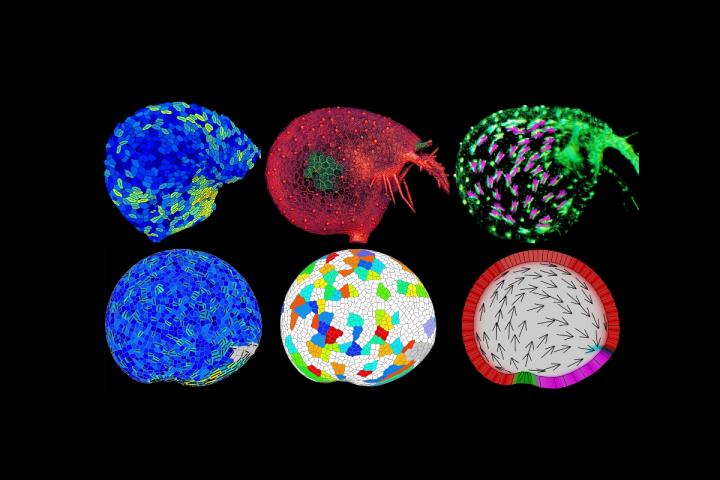
Credit: Karen Lee, Yohei Koide, John Fozard and Claire Bushell.
Leaves display a remarkable range of forms from flat sheets with simple outlines to the cup-shaped traps found in carnivorous plants.
A general question in developmental and evolutionary biology is how tissues shape themselves to create the diversity of forms we find in nature such as leaves, flowers, hearts and wings.
Study of leaves has led to progress in understanding the mechanisms that produce the simpler, flatter forms. But it’s been unclear what lies behind the more complex curved leaf forms of carnivorous plants.
Previous studies using the model species Arabidopsis thaliana which has flat leaves revealed the existence of a polarity field running from the base of the leaf to the tip, a kind of inbuilt cellular compass which orients growth.
To test if an equivalent polarity field might guide growth of highly curved tissues, researchers analysed the cup-shaped leaf traps of the aquatic carnivorous plant Utricularia gibba, commonly known as the humped bladderwort.
The team of Professor Enrico Coen used a combination of 3D imaging, cell and clonal analysis and computational modelling to understand how carnivorous plant traps are shaped.
These approaches showed how Utricularia gibba traps grow from a near spherical ball of cells into a mature trap capable of capturing prey.
By measuring 3D snapshots of traps at various developmental stages and exploring computational growth models they showed how differential rates and orientations of growth are involved.
The team used fluorescent proteins to monitor cellular growth directions and 3D imaging at different developmental stages to study the changing shape of the trap.
The computational modelling used to account for oriented growth invokes a polarity field comparable to that proposed for Arabidopsis leaf development, except that here it propagates within a curved sheet.
Analysis of the orientation of quadrifid glands, which in Utricularia gibba are used for nutrient absorption, confirmed the existence of the hypothesised polarity field.
The study which appears in the Journal PLOS Biology concludes that simple modulation of mechanisms underlying flat leaf development can also account for shaping of more complex 3D shapes.
One of the lead authors Karen Lee said, “A polarity field orienting growth of tissue sheets may provide a unified explanation behind the development of the diverse range of leaves we find in nature.”
###
The study, done in collaboration with the group of Minlong Cui at Zhejiang University in China, appears in PLOS Biology: Shaping of a three-dimensional carnivorous trap through modulation of a planar growth mechanism (link to paper).
The work was funded by the European Research Council (Carnomorph grant number 323028) and the Biological Sciences Research Council (grant nos. BB/M023117/1, BB/L008920/1, BB/P020747/1 and BBS/E/J/000PR9787).
Video – The secret of how Utricularia Gibba makes its animal sucking traps
https:/
Background information
Carnivorous plants with cup-shaped leaves traps grow in places with little nutrition. They have evolved four times independently in bladderworts (Utricularia), and pitcher plants (Nepenthes, Cephalotus and Sarracenia) to capture animal prey. Utricularia gibba was chosen for the study because of its small traps which are convenient for imaging, and its small genome size.
In the genus Utricularia (Lentibulariaceae) epiascidiate leaves, termed traps, use suction to catch prey. The traps require highly coordinated opening and closing mechanisms to operate effectively.
Utricularia is a large genus of around 235 species with different trap shapes, allowing for comparative analysis of evolutionary shape development. Modulation of growth rates and directions in response to an underlying polarity field is a mechanism that could account for the range of trap shapes seen in these species.
The genome of Utricularia gibba is among the smallest in the plant kingdom and has been fully sequenced, providing a resource for molecular genetic and evolutionary studies. Further work in the lab using Utricularia gibba as a model system is focussing on how tissue sheet formation is also dependent on the control of genes patterning each surface.
Media Contact
Adrian Galvin
[email protected]
01-603-450-238




